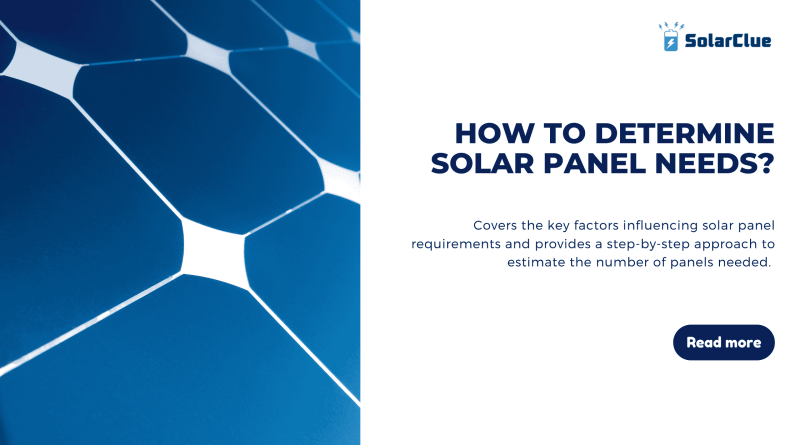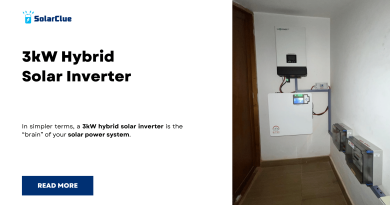How To Determine Solar Panel Needs?
Determining the optimal number of solar panels for a home or business is crucial for maximizing energy efficiency and cost-effectiveness. This blog covers the key factors influencing solar panel requirements and provides a step-by-step approach to estimate the number of panels needed. Additionally, it discusses system sizing, energy production, cost considerations, and tips for optimizing solar energy output.
Table of Contents
- 1 Understanding Energy Consumption Patterns
- 1.1 Calculating Solar Panel Wattage Based on Energy Needs
- 1.2 Assessing Roof Suitability and Available Space
- 1.3 Considering Factors like Shading and Orientation
- 1.4 Balancing System Size with Budget and Incentives
- 1.5 Using Online Solar Calculators and Design Tools
- 1.6 Optimizing Solar Panel Placement for Maximum Efficiency
- 1.7 The Role of Battery Storage in Solar System Sizing
- 1.8 Government Incentives and Rebates for Solar Panel Systems
- 1.9 Potential Challenges and Solutions in Solar Panel Sizing
- 1.10 The Impact of Net Metering on System Design
- 1.11 Long-Term Energy Consumption Projections and System Adaptability
- 1.12 Example Calculation for a Residential Solar System
- 1.13 Conclusion
Understanding Energy Consumption Patterns
Before determining the number of solar panels, it’s essential to understand the energy consumption patterns of your home or business. This involves analyzing:
Monthly and Yearly Energy Consumption: Obtain your electricity bills to calculate the average energy consumption in kilowatt-hours (kWh) per month and year.
Peak Consumption Periods: Identify the periods of the day or year when energy consumption is highest.
Energy Usage Trends: Consider any potential changes in energy consumption, such as the addition of new appliances or changes in business operations.
Calculating Solar Panel Wattage Based on Energy Needs
Once you understand your energy consumption, the next step is to calculate the solar panel wattage required to meet these needs.
Determine Daily Energy Consumption:
Estimate Peak Sun Hours (PSH): Peak Sun Hours vary by location and represent the average number of sunlight hours per day that produce 1 kW of power.
Calculate Required Solar System Size:
Determine Number of Solar Panels:
Assessing Roof Suitability and Available Space
Not all roofs are equally suitable for solar panels. Consider the following factors:
- Roof Space: Measure the available roof space where solar panels can be installed.
- Roof Orientation and Tilt: South-facing roofs with an optimal tilt angle generally receive the most sunlight.
- Shading: Identify any shading from trees, buildings, or other obstructions that might affect the efficiency of your solar panels.
Considering Factors like Shading and Orientation
Shading and the orientation of your roof play a significant role in solar panel efficiency:
- Shading: Even partial shading can significantly reduce solar panel output. Ensure your panels are placed in areas with minimal shading throughout the day.
- Orientation: In the northern hemisphere, south-facing panels receive the most sunlight. The tilt angle should match your latitude for optimal performance.
Balancing System Size with Budget and Incentives
While larger systems produce more energy, they also come with higher upfront costs. Balance your system size with your budget by considering:
- Initial Costs vs. Long-Term Savings: Larger systems save more on electricity bills but require more initial investment.
- Government Incentives: Many regions offer rebates, tax credits, and incentives that can significantly reduce the cost of your solar system.
- Net Metering: Understand how your utility company compensates for excess energy fed back into the grid.
Using Online Solar Calculators and Design Tools
There are numerous online tools available to help estimate the number of solar panels needed:
- Solar Calculators: These tools allow you to input your location, energy consumption, and roof details to estimate the required system size.
- Design Tools: More advanced tools help you design your system, including panel placement, tilt angles, and shading analysis.
Optimizing Solar Panel Placement for Maximum Efficiency
To maximize energy output, consider the following:
- Panel Placement: Ensure panels are placed in areas that receive the most sunlight throughout the day.
- Tilt Angle: Adjust the tilt angle of your panels according to your latitude to maximize exposure.
- Spacing: Ensure adequate spacing between panels to prevent shading and allow for maintenance.
The Role of Battery Storage in Solar System Sizing
Battery storage can complement your solar system by storing excess energy for use during non-sunny periods:
- Energy Independence: Batteries allow you to use stored solar energy during the night or on cloudy days, reducing reliance on the grid.
- System Sizing with Batteries: Consider sizing your system slightly larger to account for the energy needed to charge the batteries.
Government Incentives and Rebates for Solar Panel Systems
Government incentives can significantly impact the cost-effectiveness of your solar installation:
- Federal and State Incentives: Research available tax credits, rebates, and other incentives in your region.
- Net Metering Policies: Understand how your local utility compensates for excess energy produced by your solar panels.
Potential Challenges and Solutions in Solar Panel Sizing
Several challenges may arise when sizing your solar panel system:
- Space Constraints: Limited roof space may require creative solutions like ground-mounted systems or high-efficiency panels.
- Budget Constraints: Consider financing options or smaller systems with future expansion possibilities.
- Shading Issues: Use microinverters or power optimizers to mitigate the effects of shading.
The Impact of Net Metering on System Design
Net metering policies allow you to sell excess energy back to the grid:
- System Size: In areas with favorable net metering policies, it may be advantageous to size your system larger than your immediate needs.
- Energy Independence vs. Grid-Tied Systems: Decide whether you want to maximize grid-tied energy sales or focus on energy independence with battery storage.
Long-Term Energy Consumption Projections and System Adaptability
Consider future changes in energy consumption:
- Home or Business Expansion: Plan for potential increases in energy use due to expansion or new appliances.
- System Scalability: Design your solar system with the flexibility to add more panels in the future.
- Technology Advances: Keep in mind that solar technology is constantly evolving, and newer, more efficient panels may be available in the future.
Example Calculation for a Residential Solar System
| Parameter | Value |
|---|---|
| Average Monthly Energy Consumption | 1,000 kWh |
| Daily Energy Consumption | 33.33 kWh |
| Average Peak Sun Hours | 5 hours |
| Required Solar System Size | 6.67 kW |
| Individual Panel Wattage | 330 W |
| Number of Panels Required | 21 panels |
| Roof Space Required | 350 sq. ft. (approx.) |
| Estimated Cost (before incentives) | ₹5,00,000 |
| Payback Period (with incentives) | 5-7 years |
Conclusion
Determining the optimal number of solar panels involves careful consideration of energy needs, roof suitability, and financial factors. By following the steps outlined in this guide, homeowners and business owners can design a solar system that maximizes energy production, minimizes costs, and supports long-term sustainability.
Here at SolarClue®, we offer a smart, practical, and “beautiful” solution. You will be answered for all the questions related to Solar.
We provide all kinds of brands that are the Best Solar panels in India.
If you are the one who is planning for the solar power system. Don’t hesitate to contact our team!
Looking forward to empowering you with solar energy, just like hundreds of our other clients!




